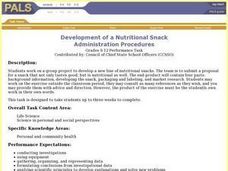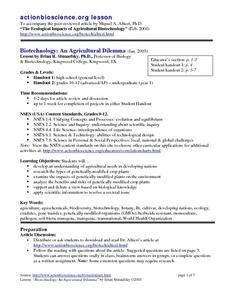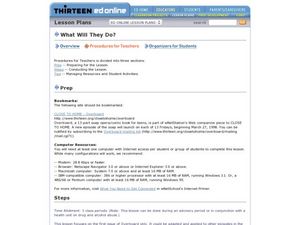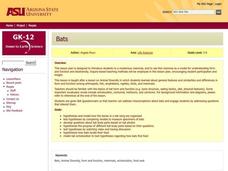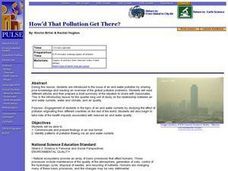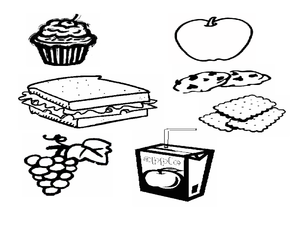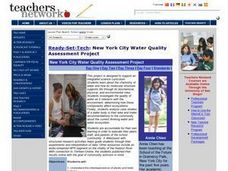Curated OER
Fish Activities
In this fish activity worksheet, students learn a counting rhyme about fish. They then discuss the best way to care for fish and they learn 4 different types of fish. On the second page, students count lines of fish and color them a...
Curated OER
Genetically Modified Foods
Students investigate the risks of genetically modified organisms. They examine web site that contain information about GMO's and share the information with other adults.
Curated OER
Development of a Nutritional Snack
High schoolers develop a new line of nutritional snacks. They work in teams to submit a proposal for a snack that not only tastes good, but is nutritional as well. Their end-product consists of four parts: background information,...
Curated OER
Plants and Animals: Partners in Pollination
Students identify the plant parts and bee structures that are involved in pollination. They simulate pollination in a group activity and process the information.
Curated OER
Animal Characteristics
Students create a graphic organizer to study animal characteristics. In this animal characteristics lesson plan, students use a program in Microsoft Word to create a brainstorm about different animal characteristics.
Curated OER
Who's Coming to Dinner?
Students identify the role predators/prey play in food chains, differentiate between food chains and webs, identify factors that affect the balance in food webs, and propose solutions to protect endangered species' environments and...
Curated OER
Biotechnology: An Agricultural Dilemma
High schoolers investigate the types of genetically modified crop plants there are and the benefits and risks of such plants. The agricultural needs in developing nations for this biological knowledge to resolve societal issues is also...
Curated OER
Will Biotech Crops Solve World Problems?
Students read an online article to examine what biotechnology and agricultural biotechnology are. They answer questions and complete worksheets based on the article's information.
Curated OER
Those Before Us
Students examine medical pioneers and identify their characteristics. They survey their contributions to the medical field and society and present persuasive argument for or against modern medical pioneers.
Curated OER
Electricity Safety Video
Young scholars discuss Picture 1 - Electrical Applicances. They discuss their prior knowledge of electricity and then listen to a video. They then answer the questions on the worksheet called, "Lesson 1 Electricity Safety Video" and...
Curated OER
Climate and Cultures of Africa
Students gain an understanding of the relationship between climate and culture in the sub- Saharan Africa. Students will complete short exercises pertaining to the various cultures of Africa and the climate in which they live....
Curated OER
Dinosaurs Were Real!
Students investigate the history of dinosaurs, as real animals. In this dinosaur lesson plan, students examine basic concepts that help them understand the history of all life. Included in this article is information on the world of the...
Curated OER
Lift and Drag: Principles of Flight and the Soaring Imagination
Learners construct models of early gas balloons and gliders. In this balloon and glider instructional activity, students create models of early gas balloons and gliders, discover how the forces of lift and drag effect aircraft in...
Curated OER
CLOSE TO HOME - Overboard
Young scholars read a comic about a teen drug overdose that leads to death. In this drug awareness lesson plan, students role play characters in the story that react to the death of their friend due to drug use in an online forum. Young...
Curated OER
Diet, Exercise and AIDS
Young scholars research AIDS and the role of diet and exercise with the disease. In this AIDS lesson, students listen to a mini lecture about the diet and exercise needs of people who have AIDS. Young scholars learn about alternative...
Curated OER
Bats
Students model how the bones in a bat wing are organized. They develop questions about bat body parts based on photographs. They hypothesize how bats locate their food.
Curated OER
Environment: How'd That Pollution Get There?
Learners examine how global wind and water patterns aid in the spread of worldwide pollution. In groups, they read articles about the domino effect of pollution and create posters displaying its journey. On blank world maps, students...
Curated OER
The Human Body
Learners research information about the human body. They read books and explore the Internet to gather information about the human body. Students create graphic representations and models of the body systems. Working in groups, they...
Curated OER
Chucky Chickadee
Young scholars create an original project dealing with birds. In this bird instructional activity, students take a virtual field trip to bird feeders around the nation. Young scholars replicate the coloring of winter birds.
Curated OER
Engineering and the Senses
Young scholars explore nutrition. In this nutrition lesson, students discuss a person's sense of taste and how it is different for each person. Young scholars discuss favorite foods and how they relate to nutrition. Students cut out...
Curated OER
RISE AND REVIEW
Pupils work in small groups to brainstorm responses to teacher posed questions as a means of review and present their Interview Projects. They present certain inventions, inventors, and scientific discoveries.
Curated OER
Rx Rainforest:
Students identify plant diversity in the rainforest and the role that animals and habitats play in scientific research. They differentiate between natural habitat and laboratory research and work collaboratively to produce a video news...
Curated OER
New York City Water Quality Assessment Project
Students investigate the chemistry of water and how its molecular structure supports life through its biochemcial, physical, and environmental roles. They investigate the quality of water as it interacts with the environment. Students...
Curated OER
Bubble and Squeak
Students complete a unit on the chemical and technological processes of food preparation. They observe various experiments, describe changes in materials through cooking, identify safety and hygiene issues, and cook various recipes.


